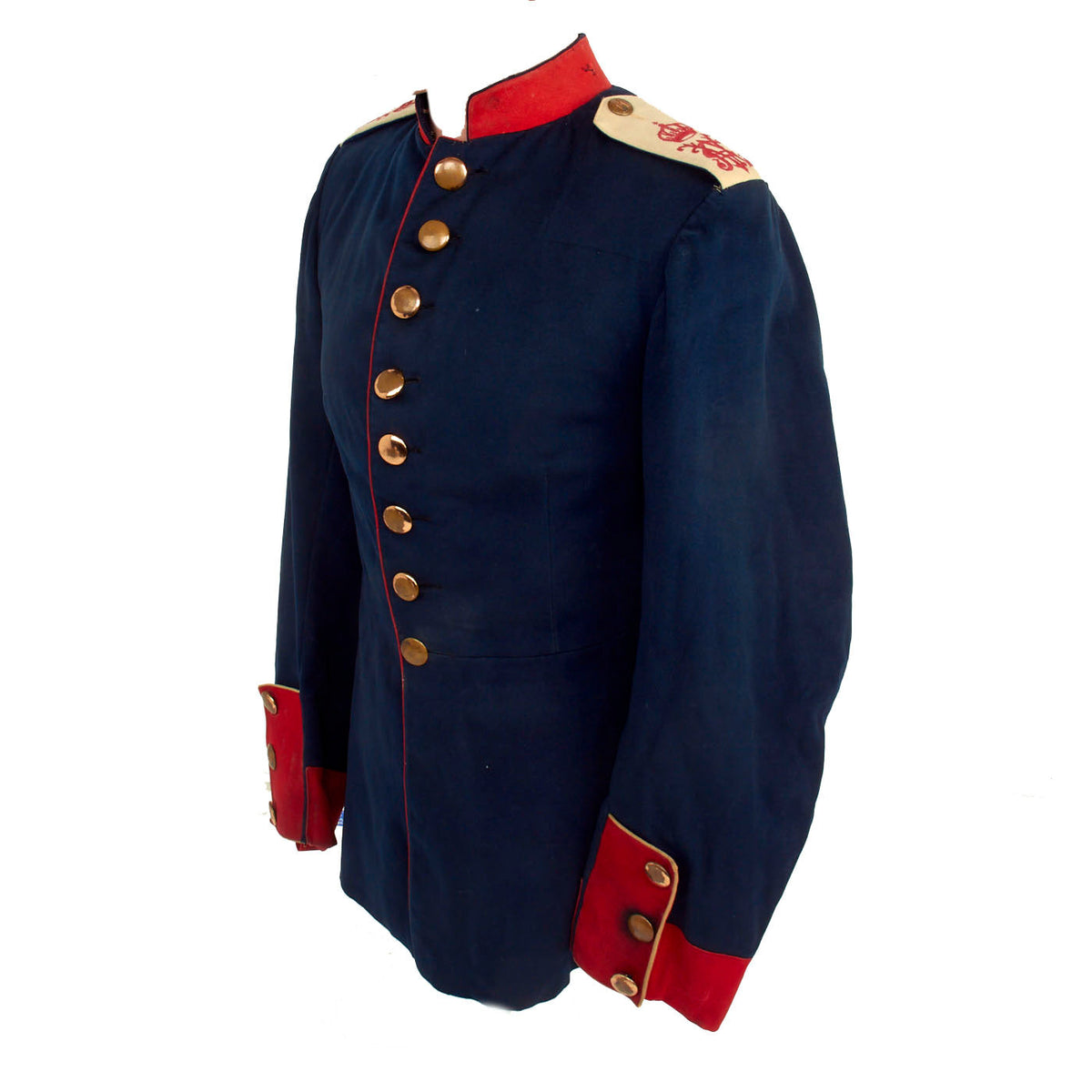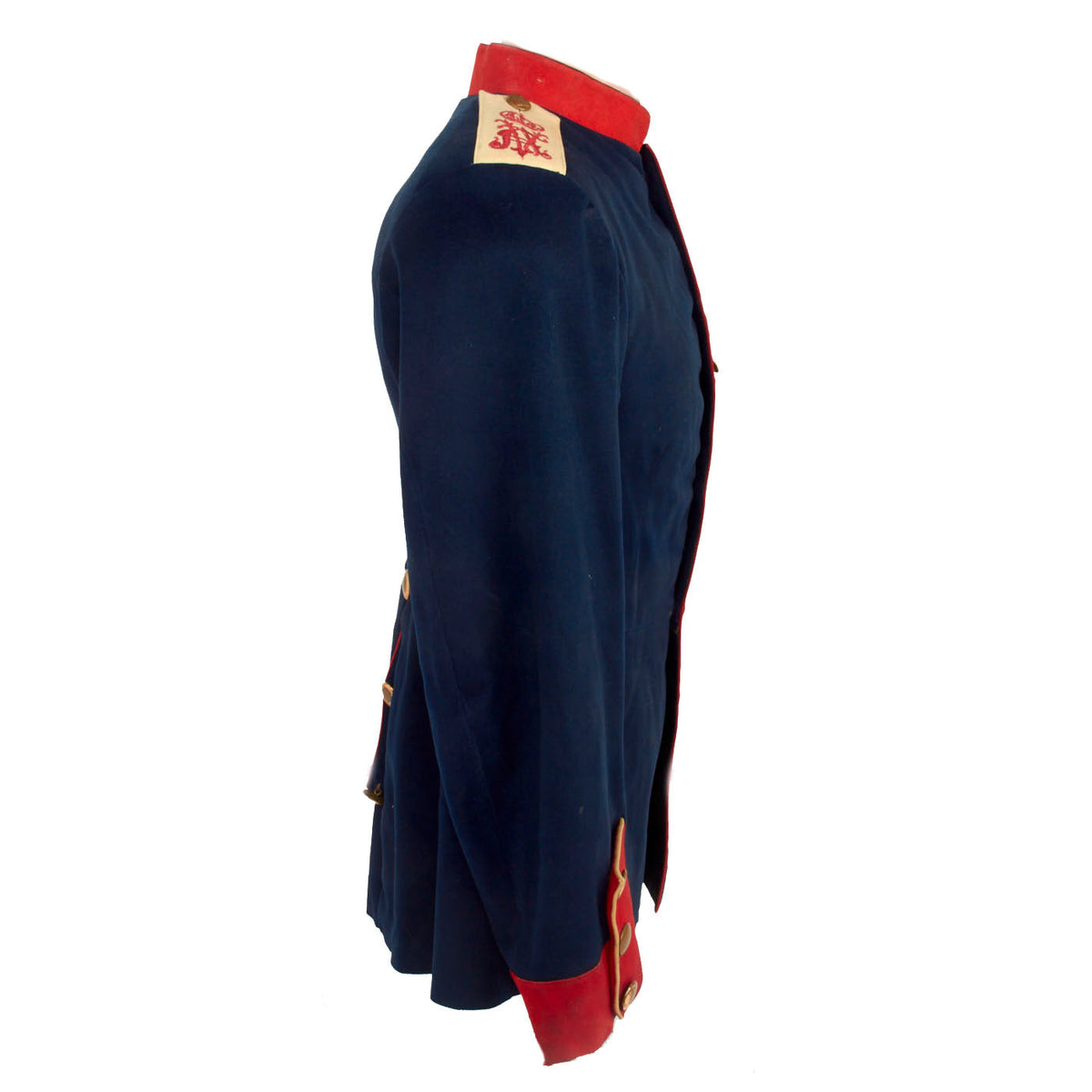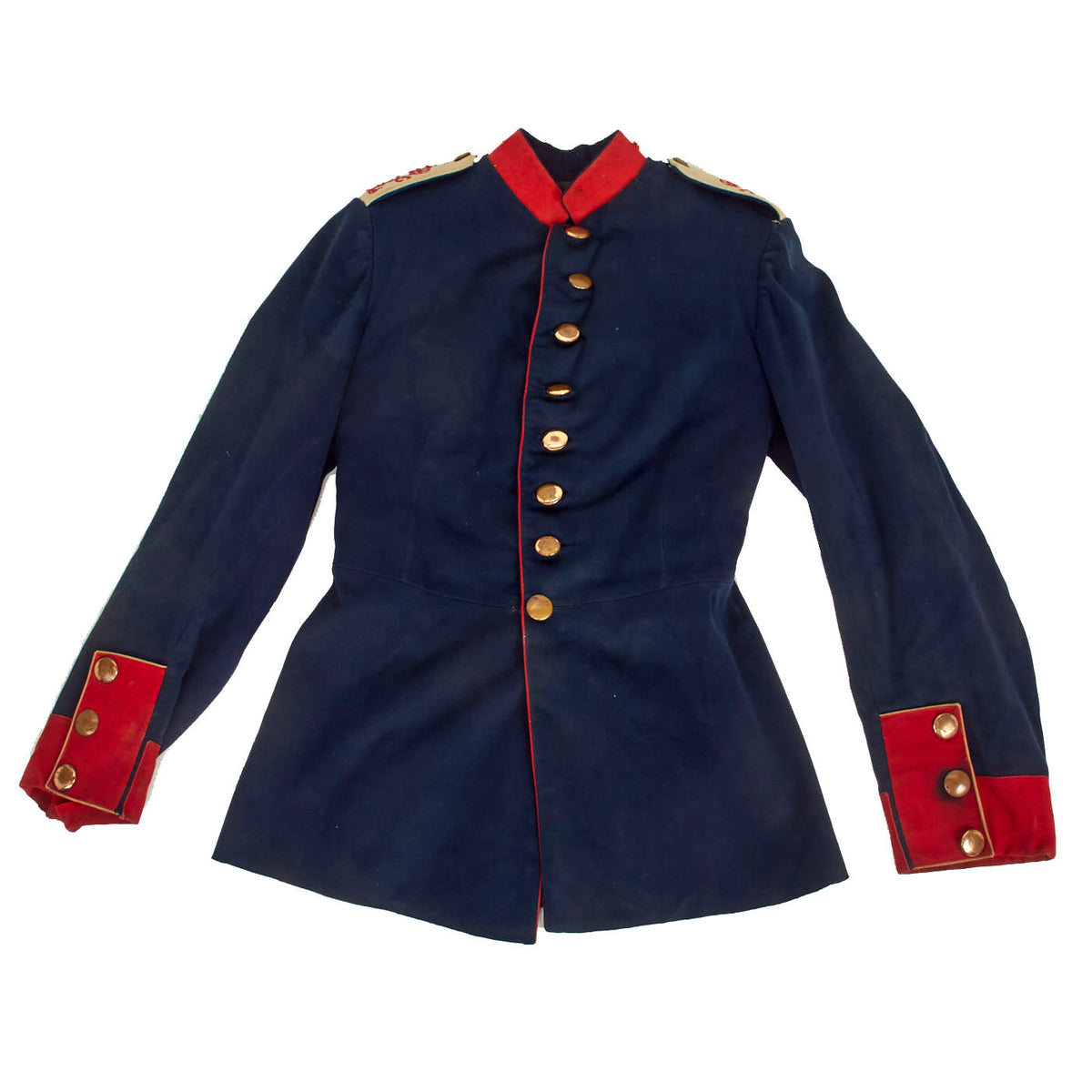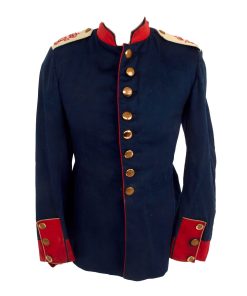Original German Pre-WWI Imperial German Prussian Army Füsilier-Regiment, Königin“ (Schleswig-Holsteinisches) Nr. 86 Dunkelblau Waffenrock Tunic Original Items
$ 895,00 $ 223,75
Original Item: Only One Available. This is a lovely M-1867 Prussian Waffenrock, featuring the beautiful Brandenburg Cuffs! In 1842, Preußen (Prussia) introduced a new pattern of uniform for all foot-troops consisting of a uniform called a Waffenrock to be worn with a tall leather spiked helmet called a Pickelhaube. This form of dress was considerably different from the short Kollet (a waist-length jacket with tails) worn with the high leather Tschako during the Napoleonic wars.
Dunkelblau (dark blue) Waffenrock were typically worn by Infantry, Feldartillerie (Field Artillery), Fußartillerie (Foot Artillery) Regiments, Train (Supply), Pionier (Pioneers) and most other units. Hellblau (light blue) Waffenrock were worn by the majority of Dragoner (Mounted Infantry) Regiments (except Hessen) while dark green Waffenrock were worn by Jäger (light Infantry) Battalions.
Issued Waffenrocks tend to be dark while Eigetumsstück (privately purchased) Waffenrocks are much lighter in color. Officer’s Waffenrock, when compared to an issued Waffenrock from the same unit, are considerably lighter in color as they were privately purchased. Conjointly, the lighter color was probably deemed “more fashionable” than the darker issued Waffenrocks of the men.
An AKO on 25 April 1895 announced the final refinements to the Waffenrock. The collar height on issue Waffenrock ranged from 4.5 to 5 cm, however, privately purchased Waffenrock invariably have higher collars ranging from 6 cm to 7 cm. Buttons were reduced in size from 25mm to 21mm. The rear skirt was given an actual vent on the M1895 Waffenrock, allowing the two rear skirt liner pockets to be accessed through a long vertical slit opening between the rear scallops. The color of the Waffenrock ranged from light to dark blue or green and the collar and cuffs came in a rainbow of colors as did the shoulder straps. The Waffenrock was to stay in this form until the eventual replacement by the M1907/10 Feldgrau Feldrock.
This M1867 has a lovely 1.5” standing collar, which is an indication of this being an issued one and not a private purchase. The color is the correct Dunkelblau and has red Brandenburg Cuffs. The Brandenburg cuff has a horizontal panel (usually red) around the circumference of the cuff, with a vertical panel superimposed on top. The vertical panel has three buttons. Both horizontal and vertical panels are often piped in the Army Corps color.
The shoulder straps bear the cipher for the Füsilier-Regiment, Königin “Queen” (Schleswig-Holsteinisches) Nr. 86. There is some mothing present on the straps and both collar buttons are missing.
The overall condition is nice but there are some factors that affect the condition. There is minor separation in the collar as well as various new and old repairs done to the lining. All buttons are present and there is some deterioration to the inner lining, as well as staining, an indication of this uniform being worn.
This is still a lovely example and not too many are left on the market! Comes ready to display!
Approx. Measurements:
Collar to shoulder: 9.5″
Shoulder to sleeve: 26″
Shoulder to shoulder: 15″
Chest width: 17.5″
Waist width: 16.5″
Front length: 30″
Hip width: 18″
Fusilier Regiment “Queen” (Schleswig-Holstein) No. 86
The association was set up after the war against Austria on September 27, 1866 from companies of the Infantry Regiments No. 16, 17, 56 and 57 by the 14th Division. It was initially called the Infantry Regiment No. 86 and received the AKO dated September 27, 1867. Allocation and recruitment regulated the provincial designation “Schleswig-Holsteinisches”. On September 9, 1890, Kaiser Wilhelm II had appointed his wife Auguste Viktoria as head of the regiment. From this point on, the association used the addition “Queen”.
The first stationing location was Halle (Saale) for the regimental staff and the 1st and 2nd battalions. The fusilier battalion was based in Zeitz . After winning the war against France , the regiment received a new garrison, which it moved into in July 1871. The regimental staff and the I. and II. Battalion was in Flensburg, the III. Battalion stationed in Sønderborg. The part of the regiment stationed in Flensburg moved into the newly built Duburg barracks in 1877.
In 1909 the regiment received a machine gun company, which was housed in the Junkerhohlweg barracks in Flensburg.
Franco-Prussian War 1870/71
The mobilization ordered on the night of July 15-16, 1870 was completed by July 24 after the arrival of the reservists. The next day the regiment moved to Mannheim and crossed the border into France near Schweigen on August 7, 1870. At the end of the month, the association took part in the fighting at Beaumont and the subsequent Battle of Sedan. This was followed by the encirclement and siege of Paris from September 19, 1870 to January 28, 1871. Parts of the regiment fought at St. Quentin on 19 January 1871.
The association remained as an occupying force in and around Meulan until May 30, 1871.
Boxer Rebellion
Two officers, ten non-commissioned officers and 56 men from the regiment volunteered to help put down the Boxer Rebellion. It was mainly used in the 3rd East Asian Infantry Regiment in China.
German South West Africa
Soldiers from the regiment volunteered again during the Herero and Nama uprisings. In 1904/06, one officer, two non-commissioned officers and 21 enlisted men were deployed in German South West Africa.
World War I
At the beginning of World War I, the regiment mobilized on August 2, 1914 and was deployed throughout the war on the Western Front . First it took part in the invasion of neutral Belgium in association with the 35th Infantry Brigade , fighting at Liège, on the Gete and at Mons. During the fighting on the Aisne from October 8, 1914, the regiment was briefly released from the brigade and returned to this large association on December 22, 1914assigned. On March 8, 1915, the association came to the 36th Infantry Brigade and received on March 22, 1915 a 13th and 14th company. From mid-October to early November 1915, the regiment took part in the autumn battle in Champagne and was then engaged in trench warfare. After the Battle of the Somme, a 2nd and 3rd MG company was formed in October 1916. During the defensive battles at Grougis, the 1st and 2nd battalions were taken prisoner. A short time later the regiment was replenished and an MW company was also added. In the ongoing fighting before and in the Hermann Positionthe 1st Battalion was taken prisoner near Tupigny. Due to the lack of replacements, the regiment could no longer be replenished and the remains were combined with the II Battalion.
Fast Shipping with Professional Packaging
Thanks to our longstanding association with UPS FedEx DHL, and other major international carriers, we are able to provide a range of shipping options. Our warehouse staff is expertly trained and will wrap your products according to our exact and precise specifications. Prior to shipping, your goods will be thoroughly examined and securely secured. We ship to thousands clients each day across multiple countries. This shows how we're dedicated to be the largest retailer on the internet. Warehouses and distribution centres can be located throughout Europe as well as the USA.
Note: Orders with more than one item will be assigned a processing date depending on the item.
Before shipping before shipping, we'll conduct a thorough inspection of the items you have ordered. Today, the majority of orders will be delivered within 48 hours. The delivery time will be between 3-7 days.
Returns
The stock is dynamic and we cannot completely manage it because multiple stakeholders are involved, including our factory and warehouse. So the actual stock may alter at any time. It's possible that you may not receive your order once the order has been made.
Our policy is valid for a period of 30 days. If you don't receive the product within 30 days, we are not able to issue a refund or an exchange.
You can only return an item if it is unused and in the same state as the day you received it. You must have the item in its original packaging.
Related products
Uncategorized
Uncategorized
Uncategorized
Uncategorized
Uncategorized
Uncategorized
Band of Brothers ORIGINAL GERMAN WWII Le. F.H. 18 10.5cm ARTILLERY PIECE Original Items
Uncategorized
Uncategorized
Uncategorized
Uncategorized
Australian WWII Owen MK1 Machine Carbine SMG Custom Fabricated Replica with Sling Original Items
Uncategorized
Uncategorized
Uncategorized
Uncategorized
Uncategorized
Uncategorized
Armored Burgonet Helmet & Polearm from Scottish Castle Leith Hall Circa 1700 Original Items
Uncategorized
Uncategorized













































































